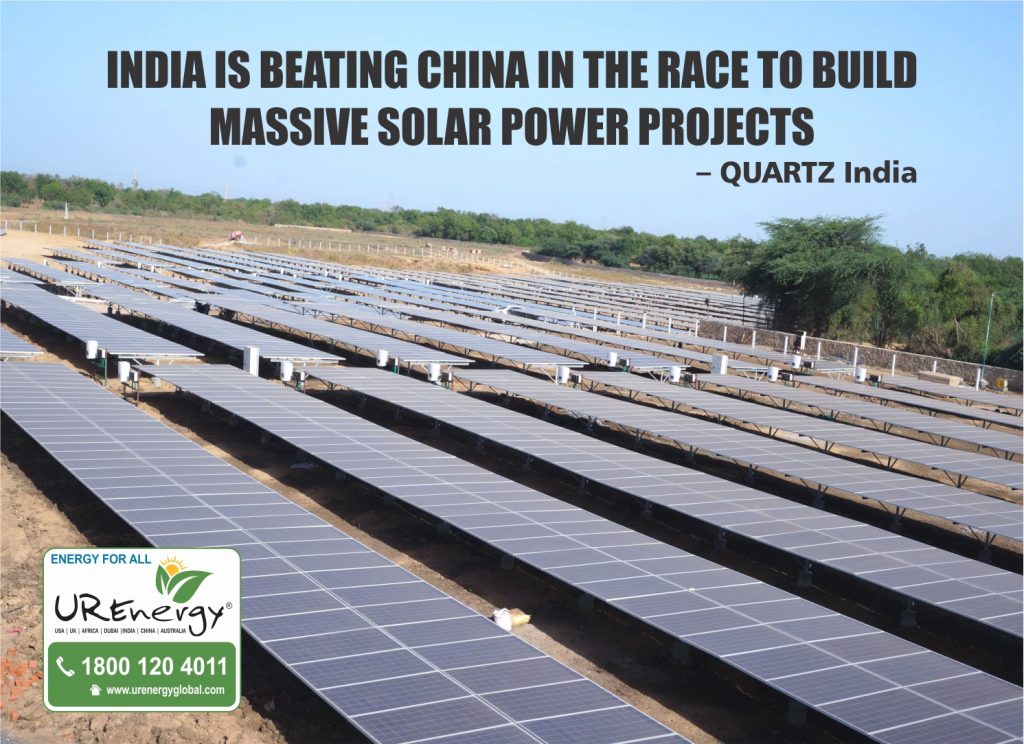
Since its big entry a decade ago, China has led the global solar energy industry. A massive manufacturing sector that has driven down costs, coupled with supportive government policies, have helped it commission multiple large-scale projects and become the world’s largest producer of solar energy.
Meanwhile, neighbouring India has turned up at the party a little late—but is now racing ahead in terms of big projects.
Half of the world’s 10 largest solar parks under construction currently are in India, says a report by US-based think tank Institute for Energy Economics and Financial Analysis (IEEFA).
| Bhadla Industrial Solar Park |
2,225 MW |
India |
| Pavagada Solar Park |
2,000 MW |
India |
| China Minsheng Investment Wuzhong Yanchi PV |
2,000 MW |
China |
| Scatec Solar Benban V PV Plant |
1,800 MW |
Egypt |
| Ananthapuramu – I Solar Park |
1,500 MW |
India |
| Mohammed bin Rashid Al Maktoum Solar Park |
1,013 MW |
UAE |
| Kadapa Ultra Mega Solar Park |
1,000 MW |
India |
| Quaid-e-Azam Solar Park |
1,000 MW |
Pakistan |
| Rewa Solar Park |
750 MW |
India |
| Enel Villanueva PV Plant |
754 MW |
Mexico |
China still has the largest ones. Its 1,547 megawatt (MW) Tengger Desert Solar Park, for instance, is the world’s biggest.
But those that India’s building are larger. For instance, by early 2019, the work on a 2,225 MW facility at Bhadla, Rajasthan, is expected to be completed. A third of this plant is already operational. Also on the cards is a massive 5,000 MW solar park along the Gulf of Khambhat in Gujarat. Even for rooftop solar installation, India has gone big. A 19 MW system installed on an 82-acre campus of the RSSB Educational and Environmental Society in Amritsar, Punjab, is currently the world’s largest.
“India has pioneered the concept of the ultra mega power plant (UMPP) in a single solar industrial park. This approach has been instrumental in driving economies of scale and procuring global capital flows…over the last two years with an immediate boon in the form of a halving of solar tariffs to a record low of Rs2.44 (per unit),” the IEEFA report said.
The country is targeting an installed capacity of 100,000 MW of solar power by 2022, up from around 21,000 MW now. It is also chasing an overall renewable energy capacity of 175,000 MW by that year.
This spike in activity has made solar energy cheaper than coal-based power and helped with capacity addition. China, meanwhile, is expected to achieve grid parity—when an alternate source of energy is as cheap or cheaper than power purchased from the grid—only by 2022, IEEFA said.
The Narendra Modi government has also been working to establish India as a clean energy leader. In March this year, for instance, the country hosted the launch of the International Solar Alliance (ISA), a non-profit group of 121 countries promoting solar energy. Industry experts saw the establishment of the ISA headquarters in India as a sign that India is claiming pole position in climate leadership.
Yet, multiple policy issues remain. For starters, there’s the expected imposition of import duties on solar panels, which could cripple growth. The country’s rooftop solar programme is also failing, with installation numbers falling short of targets.
Source By: Quartz India
Solar panel system, Residential solar panel projects, commercial / EPC solar projects, solar panel manufacturer in Ahmedabad Gujarat, Solar inverter in India


